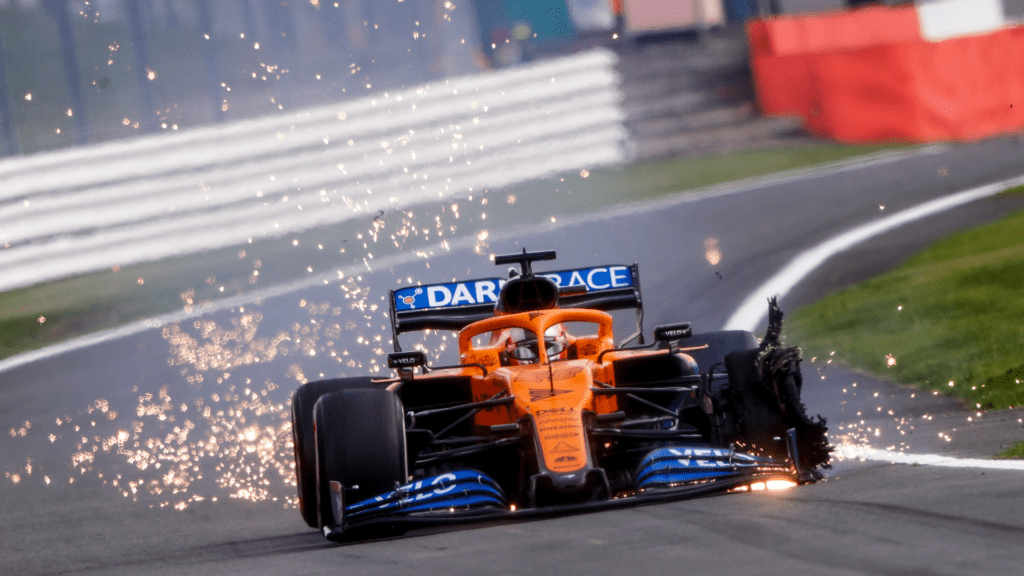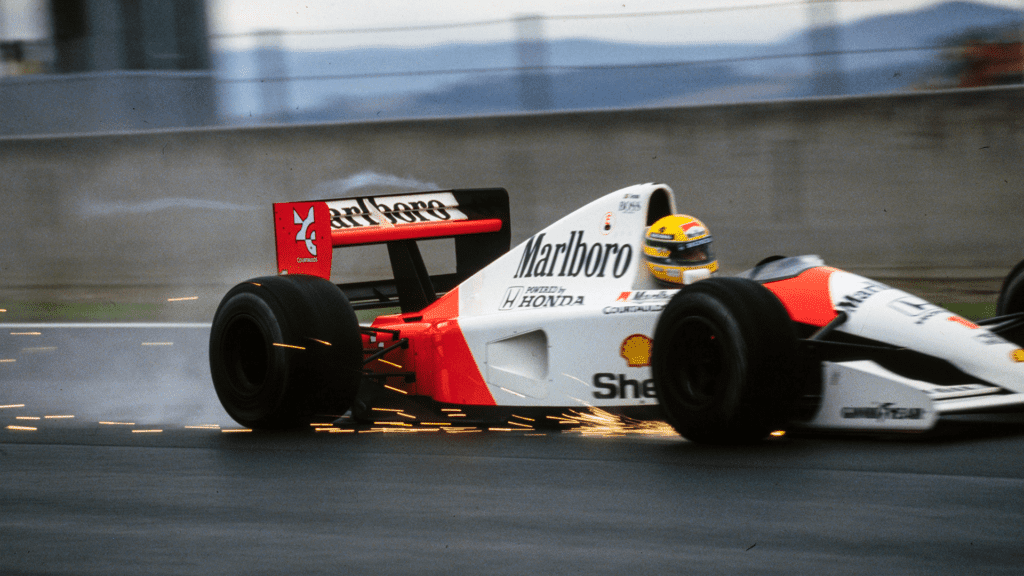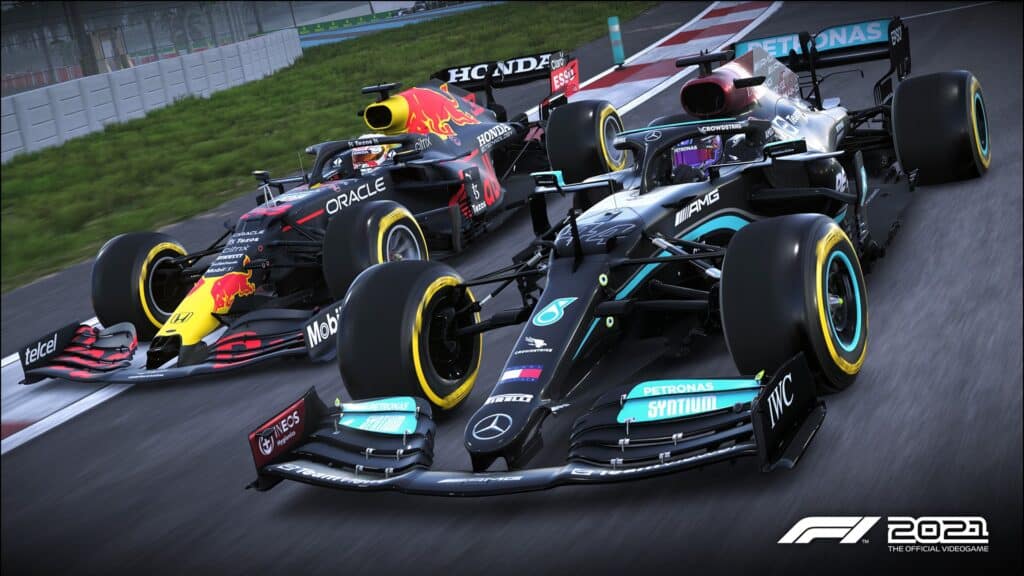After one heck of a journey throughout 2021 that wrapped up with a hugely controversial ending, the next Formula 1 season is about to begin.
With brand new regulations designed to radically transform the car and improve tighter racing, we’re all looking forward to what’s in store for this year’s journey. Can Max defend his title, will Lewis bounce back to claim an eighth championship, or will we see a brand-new warrior take the lead?
As we wait for an announcement for the latest iteration of Codemasters’ next title in the F1 game series, let’s take a look at the terms used within the game and the real-life championship.

All of these are applicable to the virtual and real versions. If we have missed any terms, please leave a comment down below as we will answer any questions you may have.
What is DRS?
DRS stands for Drag Reduction System. This allows the driver to open the rear wing, which increases top speed and reduces downforce. It can only be used within specific sections of the circuit which is usually a straight or a long flat-out section, such as after Raidillon at Spa-Francorchamps, or just before turn 15 at Interlagos.
This system can be used freely within Practice or Qualifying sessions and within dry conditions. When in the race, however, this is activated after the first two laps, and can only be used on an attacking car when it’s within a second behind an opponent when entering a DRS detection zone.
This is commonly used as an aid for overtaking, as the decreased downforce combined with a slipstream can lead to a much faster speed than an opponent, allowing the attacking car to pass faster than normal.

What is ERS?
The Energy Recovery System, or ERS for short, allows the driver to apply more power to the rear wheels from a rechargeable battery. This system harvests energy through braking and heat, allowing the battery to recharge and save power for when the driver wishes to use it.
ERS can be used at any point throughout a lap of a circuit, but the amount that you can use and harvest per lap is limited, which resets after crossing the line.
Within the game, there are four modes to choose from. 0 sets ERS to recharge the battery and doesn’t allow energy to be used, 1 sets it to medium which provides a light energy deploy, 2 sets it to hot-lap mode that is used for qualifying, and 3 is the strongest deployment.
All four modes can be used within practice, while mode 2 is the only one available in qualifying, and modes 1 & 3 are only available to be used within a race.
This system is used strategically throughout a race, as the driver will need to harvest and deploy energy to maximise lap times and to keep up with the pace. Using ERS for defensive purposes is also key, as deploying energy while the attacking driver is using DRS can help keep the car ahead.

Engine Components
The specifics don’t really need to be talked about in detail, but we’ll briefly mention the main components that make up the engine in the F1 game.
ICE, known as the Internal Combustion Engine, is the heart that drives the car. This part wears down through over-revving the engine and leads to less power.
Two components that are related to the ERS is the Motor Generator Unit Kinetic and Heat, or MGU-K and MGU-H for short, that enable a way to harvest energy through the two specified methods. Using ERS in the higher modes will lead to wear and leads to problems with energy harvesting and deployment.
ES or Energy Store is also another part that plays a role with ERS, which stores the energy harvested from the MGU-K and MGU-H. Keeping the energy charge at a high level for too long can increase wear on this component and leads to a reduction in energy capacity.

The Turbocharger also known as TC, makes use of exhaust air that powers a turbine and provides more power to the engine. The high-pitched whistling sound you can hear while driving comes from this component. The more mileage put onto this part leads to a reduction in power.
CE, known as Control Electronics, basically speaks for itself, controlling every electronic aspect of the car. Opening DRS, changing ERS modes, using the radio and much more is all down to this part. Extra stress is put onto this part when straying off-the track, and also while travelling on kerbs due to vibrations. Extra wear on this component leads to added wear on other components within the car.
Finally, the gearbox is where switching gears takes place. This component used to contain different restrictions to the other engine parts as they could only be replaced after being used for six race sessions, however, this has been limited down to 3 for the entire season for 2022. Shifting causes wear onto this component and eventually leads to specific gears being locked out to use.
Tyre Compounds
Every team is able to choose between 5 different tyre compounds, all ranging with different types of softness and durability. The three dry compounds are softs in red, mediums in yellow, and hards in white. The softer tyre contains more grip to the track and leads to faster lap times, but also degrades much faster than the harder compounds.
On the opposite end, the harder compounds are slower, but last a lot longer compared to the softer compounds. During a dry race, every driver must use at least two different compounds to ensure a pit-stop has been made, but these rules are disregarded for a wet race.

The other two compounds are set aside for wet weather, being intermediate in green and wet in blue. The intermediate tyres contain a small groove that displaces water and is suitable for slippery conditions such as light rain or standing water. The wet tyres contain a much larger groove and displace a higher amount of water than the intermediates, as this is reserved for heavy rain conditions.
Choosing the right tyre is crucial for the race. If the driver is on a dry compound while light rain is occurring, the track can become undrivable and lead to a spin. For example, look at what happened to Lando Norris during the final five laps at Sochi in 2021. On the other end, using a wet compound on a dry circuit leads to hotter temperatures in the tyres, leading to a lack of grip and tremendous degradation.
What does The Cliff mean in F1?
Speaking of degradation, you may have heard of tyres falling off the cliff. No, this does not mean they are chucking them off of a precipice, this term refers to its performance. As more laps are driven on a set of tyres, the amount of rubber wears down and the grip decreases.
When the degradation hits a specific point, the amount of grip loss is significant compared to the previous few laps and putting the performance on a graph shows it takes a sharp dive down, forming a sort of cliff shape. Hence the term, tyres falling off the cliff.

What is a Lock Up?
As the driver applies the brakes, the force slows the rotation of the tyre down and increases heat to the tyres and brakes in the process. If there is too much force applied to the brakes, they can stop the rotation of the tyre while the car continues to move forwards.
This causes huge wear on the tyre, as the car skids under braking and grinds the tyre as it scrapes along the road, hence being called a lock-up. The tyre can lose multiple layers of rubber, causing a flat edge to appear and intense vibrations throughout the car, leading to an uncomfortable ride and loss of grip.
Every corner within a circuit will need a different amount of force into the brakes, and the driver has to constantly hit this unknown edge to perfect braking performance.

What are marbles in F1?
As a car runs throughout a race, the four tyres begin to shed layers and leads to shards of rubber being thrown out onto the circuit. With all 20 cars racing and putting tremendous loads into their tyres, this causes a layer of rubber shards to appear on the surface of the track that isn’t on the racing line.
Straying into these shards causes a huge loss of grip, just like walking on a bunch of loose marbles and giving the stray rubber this term.

Box, box, box
As you reach the end of a lap, you’ll most likely hear “Box, box, box” over the radio from Jeff. This term is telling the driver to come into the pits to either chuck on a fresh set of tyres, or to unfortunately retire the car during a race.
However, you may be thinking “but why don’t they use pit, pit, pit”? This could be down to the word “Box” being easier to distinguish than “Pit” while racing at around 200 miles an hour, with the word phonetically clearer and louder. It’s also an abbreviation of the German word for pitstop: Bóxenstopp.
Speaking of pit stops, every team comes up with a plan to maximise tyre performance throughout the race, also known as strategy. A typical strategy contains a short stint on soft tyres, followed by a longer stint on medium or hard tyres. These differ for each circuit, so if one strategy works well at Monza, it may not work well at Suzuka.

What are Undercut and Overcut?
These are commonly used throughout every race and differs for each track within the calendar. The terms define a tactic used to overtake an opponent in front but can also be used by the defender to maintain their position on track.
Starting with the undercut, this begins with two cars out on track with worn tyres, with the attacking car pitting first, putting on a fresh set of tyres and ending out in front of the car they were originally chasing.
As an example, let’s have driver A and driver B as they’re 20 laps into the race with worn tyres. Driver B is a second behind Driver A, and decides to come into the pits. They throw on fresh tyres while Driver A is still on track with worn tyres, and comes into the pit on the same lap for fresh tyres.

As they leave the pits, they find themselves overtaken by the attacking driver, even if both pit stop lengths were exactly the same. This is due to the lap taken once Driver A passed the line, and Driver B left the pits.
Driver A is running this lap with worn tyres and leads to a slower lap, while Driver B is on brand new tyres and ends up completing this lap a couple of seconds faster than Driver A, leading to an overtake due to the significant time gain by the attacking driver.
An overcut is the same principle but in reverse. Brand new tyres may need some time to heat up and can cause a loss of grip and a slower time than a driver on worn tyres. This is less common than an undercut, as there aren’t many tracks on the calendar that maintain the ability for an overcut.
Slipstream, Tow, Dirty Air and Clean Air
Aerodynamics is everything when it comes to Formula One cars. As a car travels through a circuit at speed, it is subject to air resistance that applies a rearward force and drags the car backwards. This leaves a hole in the air behind the car as it creates an area of low pressure and can be exploited by a following car.
This process is called Slipstreaming, where the car behind is not subject to the same forces as the car in front and leads to a speed increase.
A tow is commonly used by drivers within the same team and takes advantage of the slipstream effect. For example, Ferrari is running in a qualifying session at Monza. Carlos Sainz is a couple of seconds in front of Charles Leclerc after exiting Curva Alboreto and allows him to use his slipstream. Once Leclerc is close, Sainz moves off the racing line to allow Charles free air when going into the braking zone for the first chicane.

When it comes to following a slipstream during the corners, however, this can lead to a compromise. The loss of downforce while slipstreaming is perfect for the straights but causes huge problems as soon as you need those forces for turning. This is called Dirty Air, as the car in front disturbs the aerodynamic capabilities of the opponent behind.
Flags
We’ve covered this topic in full within another video. If there are any specific flags you have additional questions on, feel free to leave a comment down below.

What is a backmarker?
A backmarker describes a car that is about to be lapped and isn’t in the fight for the lead. Once a car is about to lap them, they will be shown the blue flag that signals them to slow down and let these cars by. There are different rules concerning blue flags for other series, but the backmarker must adhere to the F1 rules to not face a penalty.

Formula 1 weekend format
Depending on your settings, the F1 games contain varied lengths for each session, but we’ll talk about the standard Formula One weekend format.
The weekend kicks off on Friday with two practice sessions, each lasting an hour. This time is used to try out different tyres, different engine settings and to acclimatise to the track conditions.
Next up is Saturday, with one final practice session left to tie any loose ends up. Teams usually use this period for testing their maximum pace around the track, as the next session is only a few hours away.
Then it’s qualifying, where every driver tries to gain the fastest time around the track. This session is split up into 3 parts, Q1, Q2 and Q3. Starting off with Q1, all 20 cars have 18 minutes to set the fastest lap around the track.

Once the time is up, the five slowest drivers are eliminated and start tomorrow’s race between 20th and 16th. The times are then reset for Q2, with 15 drivers going at it again for 15 minutes and the slowest 5 drivers eliminated and start the race between 15th and 10th.
Finally, Q3 lasts for 12 minutes with the remaining 10 drivers and dictate the final top 10 positions according to their fastest laps within this session.
This all leads to Sunday’s grand finale, the race. The grid lines up according to the times set in the qualifying session, and it’s lights out and away we go for 300km.
A new introduction to 2021’s schedule is the sprint qualifying session. This changes up the weekend to be one practice and qualifying session on a Friday, and one practice and Sprint Qualifying sessions on Saturday.
This new session works in a similar vein to the race session, but is shortened by two-thirds, with the final positions determining the grid for the race on Sunday. The sprint is only within 3 races on the calendar, and we’ll have to wait and see whether this session will be part of the F1 2022 game.

What is a Superlicense?
These next few terms are specific to the real F1 championship, and occasionally pop up during a broadcast. A Superlicense is a license held by a driver that is required to race in Formula One. Drivers will have to work their way up to gain 40 points in certain series, with all of them having different values per position.
For example, coming 1st, 2nd or 3rd in Formula 2 gains 40 points, coming 1st in the NASCAR Cup Series gains 15 points and finishing 4th in a Formula E championship gains 10 points.

What is Silly Season?
Silly Season refers to the majority of teams changing up their driver lineups in a sort silly round of musical chairs. Crazy rumours are sent wild before each announcement, and it should be taken with a pinch of salt until the team confirms their lineup. As an example, there were 12 driver changes before the 2021 season had started. Mental.
What is Porpoising?
This refers to the harsh bouncing issue drivers are facing while going down a straight in the new 2022-generation F1 cars, leading to the bottom of the car hitting the road and a dangerous grip loss as it rebounds back up. As we head into the first race of the season, teams need to quickly find a solution before it’s too late.

If you have any additional questions regarding Formula 1 and the game, then please leave a comment in the section down below, and we will get back to you as soon as we can.





Chat with the Community
Sign Up To CommentIt's completely Free